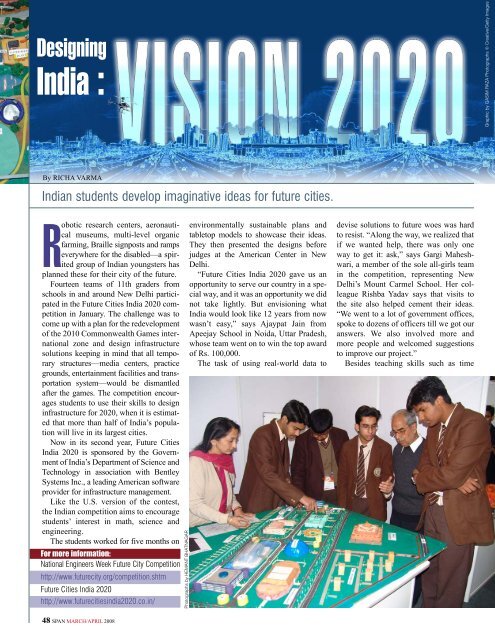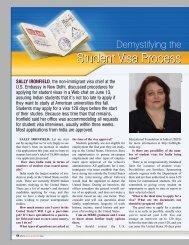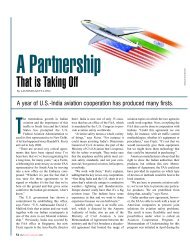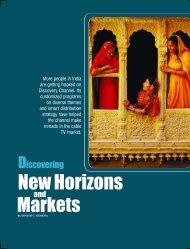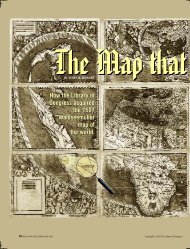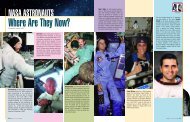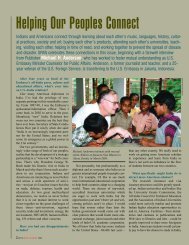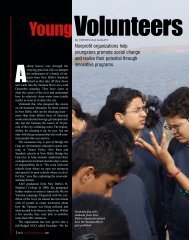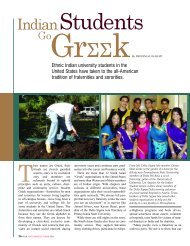Designing India: Vision 2020, SPAN March/April 2008
Designing India: Vision 2020, SPAN March/April 2008
Designing India: Vision 2020, SPAN March/April 2008
Create successful ePaper yourself
Turn your PDF publications into a flip-book with our unique Google optimized e-Paper software.
<strong>Designing</strong><br />
<strong>India</strong> :<br />
By RICHA VARMA<br />
<strong>India</strong>n students develop imaginative ideas for future cities.<br />
Robotic research centers, aeronautical<br />
museums, multi-level organic<br />
farm ing, Braille signposts and ramps<br />
everywhere for the disabled—a spirited<br />
group of <strong>India</strong>n youngsters has<br />
planned these for their city of the future.<br />
Fourteen teams of 11th graders from<br />
schools in and around New Delhi participated<br />
in the Future Cities <strong>India</strong> <strong>2020</strong> competition<br />
in January. The challenge was to<br />
come up with a plan for the redevelopment<br />
of the 2010 Commonwealth Games international<br />
zone and design infrastructure<br />
solu tions keeping in mind that all temporary<br />
structures—media centers, practice<br />
grounds, entertainment facilities and transportation<br />
system—would be dismantled<br />
after the games. The competition encourages<br />
students to use their skills to design<br />
infrastructure for <strong>2020</strong>, when it is estimated<br />
that more than half of <strong>India</strong>’s population<br />
will live in its largest cities.<br />
Now in its second year, Future Cities<br />
<strong>India</strong> <strong>2020</strong> is sponsored by the Govern -<br />
ment of <strong>India</strong>’s Department of Science and<br />
Technology in association with Bentley<br />
Systems Inc., a leading American software<br />
provider for infrastructure management.<br />
Like the U.S. version of the contest,<br />
the <strong>India</strong>n competition aims to encourage<br />
students’ interest in math, science and<br />
engineering.<br />
The students worked for five months on<br />
For more information:<br />
National Engineers Week Future City Competition<br />
http://www.futurecity.org/competition.shtm<br />
Future Cities <strong>India</strong> <strong>2020</strong><br />
http://www.futurecitiesindia<strong>2020</strong>.co.in/<br />
48 <strong>SPAN</strong> MARCH/APRIL <strong>2008</strong><br />
Photographs by HEMANT BHATNAGAR<br />
environmentally sustainable plans and<br />
tabletop models to showcase their ideas.<br />
They then presented the designs before<br />
judges at the American Center in New<br />
Delhi.<br />
“Future Cities <strong>India</strong> <strong>2020</strong> gave us an<br />
opportunity to serve our country in a special<br />
way, and it was an opportunity we did<br />
not take lightly. But envisioning what<br />
<strong>India</strong> would look like 12 years from now<br />
wasn’t easy,” says Ajaypat Jain from<br />
Apeejay School in Noida, Uttar Pradesh,<br />
whose team went on to win the top award<br />
of Rs. 100,000.<br />
The task of using real-world data to<br />
devise solutions to future woes was hard<br />
to resist. “Along the way, we realized that<br />
if we wanted help, there was only one<br />
way to get it: ask,” says Gargi Mahesh -<br />
wari, a member of the sole all-girls team<br />
in the competition, representing New<br />
Delhi’s Mount Carmel School. Her colleague<br />
Rishba Yadav says that visits to<br />
the site also helped cement their ideas.<br />
“We went to a lot of government offices,<br />
spoke to dozens of officers till we got our<br />
answers. We also involved more and<br />
more people and welcomed suggestions<br />
to improve our project.”<br />
Besides teaching skills such as time<br />
Graphic by QASIM RAZA Photographs © Creative/Getty Images
management, problem solving and teamwork,<br />
the competition gave students an<br />
introduction to civil, electrical, chemical<br />
and mechanical engineering.<br />
Scott T. Lofgren, global director of<br />
Bentley Empowered Careers Network,<br />
which is part of Bentley Systems Inc.,<br />
says: “Future Cities <strong>India</strong> <strong>2020</strong> is a tribute<br />
to all those who have developed innovative<br />
design solutions to help address<br />
<strong>India</strong>’s real-world infrastructure needs.”<br />
Though he is not sure if the students’<br />
ideas will be used by the administration,<br />
the competition has “definitely stirred an<br />
interest in infrastructure engineering.”<br />
Ayush Srivastav of DAV Public School<br />
in Gurgaon, Haryana, says he learned soldering<br />
and making electrical connections,<br />
things he had only read about. “There<br />
were times we burnt our hands handling<br />
the hot charcoal to make the miniature<br />
roads in our model. The experience will<br />
remain with me as it gave me a confidence<br />
of attempting the unknown,” Srivastav<br />
says of the efforts of his team, which came<br />
second.<br />
“We were trained in using state-of-theart<br />
modeling software like MXROAD<br />
and MicroStation V8XM by Bentley. We<br />
learnt about 3D analysis and new innovations<br />
in architecture,” says Apeejay’s<br />
Ajaypat Jain, who is 16 years old. “We<br />
even devised a new technology like...the<br />
robot mechanized navigation system for a<br />
very futuristic building system called the<br />
Simulation Center.”<br />
Says 16-year-old Akansha Sharma<br />
from Apeejay School in Faridabad,<br />
Haryana, “The long hours of research and<br />
work that has gone into this project have<br />
sparked a desire in me to carry this on. In<br />
fact, we often discuss that we should form<br />
an architecture firm when we grow up.”<br />
Sharma’s teacher, Mamta Arora, says<br />
the students sometimes put in 11-hour sessions<br />
designing and redesigning their presentations.<br />
Each team was guided by a<br />
teacher, often a specialist in computers or<br />
science, and an engineer who volunteered.<br />
Despite the disparity of design, one idea<br />
cut across all groups: making the project<br />
environment friendly. From solar-powered<br />
vehicles, solar panels on rooftops and<br />
rainwater harvesting to using bricks made<br />
from fly ash, and no-vehicle zones, the<br />
students wanted their future cities to be<br />
pollution-free.<br />
“Global warming is the issue of the day<br />
and I’m sure by <strong>2020</strong>, we will be in the<br />
middle of a severe climate crisis. We<br />
don’t want to leave a large carbon footprint<br />
for our kids. And anyway, planning<br />
ahead never hurt anyone. It’s better to<br />
think now than repent later,” says<br />
Left: The team from Apeejay School in Noida explains its design concept to an audience<br />
member. From left are team mentor and biology teacher Pinky Mathur, students Ajaypat<br />
Jain, E.R. Subramanian, Gagan Anand and Anshul Singh.<br />
Below: Students Zoya Khan, Pourav Banerjee and Abhinav Mittal of New Delhi’s Apeejay<br />
School interact with Scott T. Lofgren (center), global director of Bentley Empowered<br />
Careers Network and Jugal Makwana of Bentley Systems in <strong>India</strong>.<br />
Graphic by HEMANT BHATNAGAR Photographs © Creative/Getty Images<br />
Future Dilemma:<br />
Too Many People,<br />
Too Little Space<br />
From 13 percent in 1900, the global proportion<br />
of urban dwellers increased to 49<br />
percent in 2005. According to projections<br />
by the United Nations Populations Division, 60<br />
percent of the world’s population, or about 4.9<br />
billion people, are expected to live in cities by<br />
2030.<br />
By 2015, Mumbai will be the world’s second<br />
most populous city, with an estimated population<br />
of 20.9 million. New Delhi and Kolkata will<br />
remain among the most populous cities, and it<br />
is also anticipated that Mumbai and New Delhi<br />
will grow faster than any other city in the world.<br />
Population scientist Joel E. Cohen, author of<br />
How Many People Can the Earth Support?, said<br />
at a panel discussion organized by the<br />
American Academy of Arts and Sciences:<br />
“From now to 2030, the world will need to build<br />
the equivalent of a city of one million in developing<br />
countries every five days,” reported a<br />
New York Times blog.<br />
The question is, how long can the earth sustain<br />
and support this everincreasing<br />
population,<br />
which is projected to<br />
increase from 6 billion<br />
in 1999 to 9 billion<br />
by 2042.<br />
Akansha Sharma, whose favorite pastime<br />
is bird-watching.<br />
Spending what was the busiest winter<br />
vacation of their lives, the students agreed<br />
they had had an incomparable experience.<br />
“The project was challenging and we<br />
did get stuck at times but our teachers and<br />
our team spirit always rescued us,” says<br />
Ajaypat Jain. “More than the prize, it is the<br />
experience that will remain with us.”<br />
Please share your views on this article.<br />
Write to editorspan@state.gov<br />
<strong>SPAN</strong> MARCH/APRIL <strong>2008</strong> 49<br />
URBAN DEVELOPMENT


